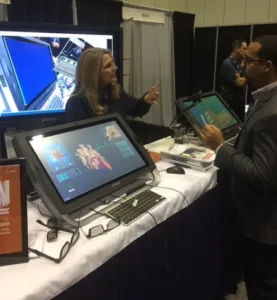The January release of the U.S. 2016 National Education Technology Plan (NETP), Future Ready Learning: Reimagining the Role of Technology in Education, by the Office of Educational Technology is already turning heads. And I have to stop and clarify that there’s no fluff here.
Past national education technology plans have been well received by U.S. K12 schools; their recommendations have slowly been adopted country wide, due to incentives and organic pressure from federal, state, local, and even foundation funding. Look at the history of the NETP. One of the first NETPs called for the Internet to reach every school. The next NETP sought to have the Internet reach into each classroom in a school. More recent plans called for increased opportunities for online learning in K12 education within the U.S. And the previous NETP sought a platform for increased personalization of learning. Each of these plans, followed by persistent political priming and stoking—over a five year period—was successful in pushing the engine of technological change in U.S. schools. I am simply suggesting that, given the past impact of previous NETPs, this new NETP is due serious consideration.
Now—on to some interesting specifics. One of the chapters in the 2016 National Education Technology Plan (NETP) is necessarily more forward looking than the other sections, spotlighting some of the upcoming areas of cyberlearning in the classroom. “The Future of Learning Technologies” section of the 2016 NETP is an attempt to move the reader beyond an “understanding of the current state of educational technologies; it also [identifies] the research being done on early-stage educational technology and how this research might be applied more widely in the future to learning.” In fact, the NETP highlights four promising avenues for future learning technologies, based chiefly on the investigative work of the National Science Foundation in “researching opportunities offered by integrating emerging technologies with advances in the learning sciences.” These auspicious avenues include:
- Increased use of games and simulations
- New ways to connect physical and virtual interaction with learning technologies
- Interactive three-dimensional imaging software
- Augmented reality (AR)
Most notably to our Display Daily readers, the subsection on interactive three-dimensional imaging software spotlights a well-known company and a product used by tens of thousands of students across the country: zSpace. Quoting from page 16 of the 2016 NETP:
Interactive three-dimensional imaging software, such as zSpace, is creating potentially transformational learning experiences. With three-dimensional glasses and a stylus, students are able to work with a wide range of images from the layers of the earth to the human heart. The zSpace program’s noble failure feature allows students constructing a motor or building a battery to make mistakes and retry, learning throughout the process. Although the content and curriculum are supplied, teachers can customize and tailor lesson plans to fit the needs of their classes. This type of versatile technology allows students to work with objects schools typically would not be able to afford, providing a richer, more engaging learning experience.
But there’s so much more to the story. Please allow me to fill in some of the blanks—to read between the lines—for the sake of our Display Daily readers. First, we need to realize that some visualization technologies, like zSpace, can multi-task in their purpose: they can serve several educational agendas at the same time. Let me explain. Take for example the NETP’s four categories for future technologies that offer educational promise (remembering that 3D visualization was mentioned in only the third category):
- Increased use of games and simulations. The zSpace curriculum itself is designed around a rich collection of STEM-based games and simulations.
- New ways to connect physical and virtual interaction. The “near-holographic” zSpace hardware platform makes the content appear not on a screen, but in the students’ own personal space, manipulated by a physical stylus. And the cooperative (paired) learning approach promoted by the zSpace STEM Lab also brings a physical presence and process to each visualization lesson.
- Interactive three-dimensional imaging software. ‘Interactive’ being the key word here, the zSpace platform is not just about viewing or watching—it’s mainly about doing, constructing, testing, evaluating, and rebuilding. Rinse and repeat.
- Augmented reality. Interestingly, the zSpace zView enhancement lets an entire class—not just the students wearing passive glasses—see each simulation in starkly vivid augmented reality.
Although, in the 2016 NETP, the 3D visualization meme was positioned solely in the third category above, clearly some technologies work across lanes. I am suggesting that some successful 3D visualization products, like zSpace, operate in all four of these domains.
zSpace at the 2016 FETC conference
On another track, I do not agree with the NETP editors who suggest that zSpace and other visualization technologies represent an “early-stage educational technology.” For several years now, zSpace has been drawing large crowds and winning best-of-show awards at conferences, while proving itself as an impactful learning tool in classrooms around the country. Many other visualization technologies I know in classrooms today are quite robust and mature. Rather, U.S. schools, having just emerged from the fiscal constraints of the great recession, are still revving up their engines to move toward some of the inventive technologies that already exist.—Len Scrogan

